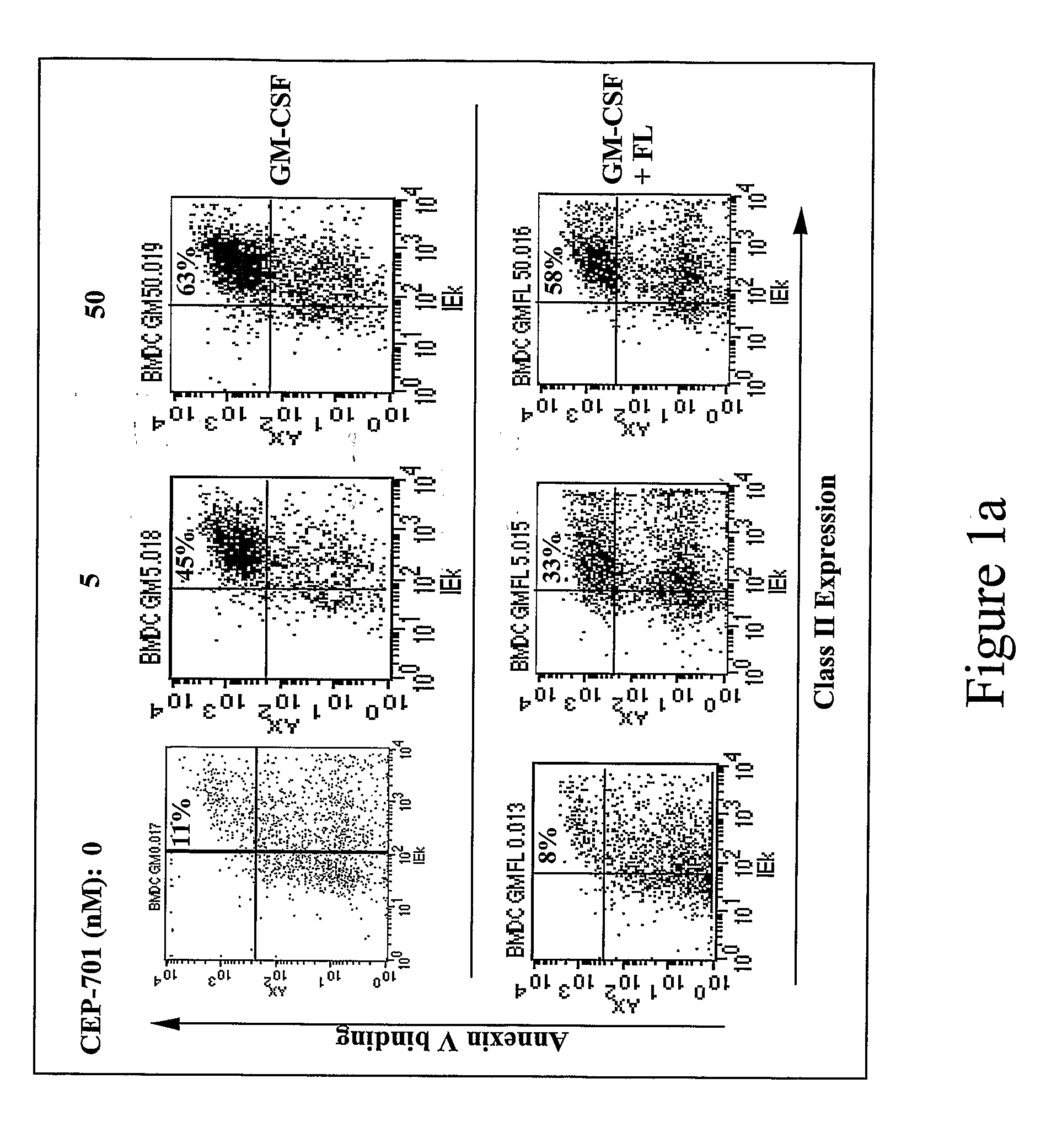Flt3 inhibitors for immune suppression
a technology of immune suppression and inhibitors, applied in the field of suppressing an immune response, can solve the problems of severe immunosuppression, devastating and irreversible side effects for individuals, etc., and achieve the effects of suppressing the immune response of a cell, reducing the number of dendritic cells (dc), and reducing the ability to activate t cells
- Summary
- Abstract
- Description
- Claims
- Application Information
AI Technical Summary
Benefits of technology
Problems solved by technology
Method used
Image
Examples
example 1
Treatment of Mature DCs with FLT3 Inhibitors Induces Apoptosis in Mature DCs
[0180]The survival and function of the DCs was investigated when exposed to FLT3 inhibitors. Mature DCs were incubated in a dose-response analysis to CEP 701, 5214 and AG 1296 in the presence of GM-CSF+ / −FL. A decrease in survival and stimulation of the DCs was observed.
[0181]Bone marrow (BM) was flushed from the extremities of mice with PBS, red blood cells (RBCs) were lysed in hypotonic buffer, and after washing the cells were plated at 2×106 cells / ml in GM-CSF (1000 U / ml) or GM+FL (100 ng / ml) containing medium. On days 2, 4, and 6, non-adherent cells were removed and adherent cells were washed prior to the addition of fresh medium. On day 8, non-adherent mature DCs were harvested, and replated in the absence or presence of CEP-701 at 5 or 50 nM. After 24 hours, cells were then stained for FACS analysis. CD11c+ cells were assessed for MHC class II expression and Annexin V binding (FIG. 1A). CEP-701 induced...
example 2
[0184]FLT3 inhibition decreases DC-based proliferation of T cells. For these experiments, DCs were generated as above from BALBc mice. The cells were left untreated or were treated with CEP701 and then plated with C57BL / 6 splenocytes at the ratios shown. After 3 days, 3H was added, and the proliferation determined. As FIG. 2A shows, CEP701 had a robust effect on decreasing proliferation. In FIG. 2b, BALB / c splenocytes were substituted for DCs, in order to test the inhibition of CEP701 on a standard mixed lymphocyte reaction (MLR). As this figure also shows, this response was also inhibited in the presence of CEP701.
[0185]To determine whether T cell stimulatory response would be inhibited as a result of exposure to AG1296, two different T cell proliferative assays were conducted. FIG. 2c shows the results of co-incubating spleen cells from allogeneic mice in the presence (10 μm) or absence of inhibitor. In this standard mixed lymphocyte reaction, equal numbers of stimulator and respo...
example 3
Treatment of T Cells Directly does not Inhibit their Proliferation
[0186]To show that the inhibition observed in FIGS. 2a and b was due to an effect of the inhibitor on the DCs and not the T cells themselves, 1×106 T cells were plated on anti-CD3 coated plates. T cells were then stimulated with anti-CD28 antibody. After 2 days, 3H was added, and the proliferation determined. As the figure shows, no effect on direct stimulation of T cells was observed.
PUM
| Property | Measurement | Unit |
|---|---|---|
| Immunogenicity | aaaaa | aaaaa |
| Disorder | aaaaa | aaaaa |
Abstract
Description
Claims
Application Information
 Login to View More
Login to View More - R&D
- Intellectual Property
- Life Sciences
- Materials
- Tech Scout
- Unparalleled Data Quality
- Higher Quality Content
- 60% Fewer Hallucinations
Browse by: Latest US Patents, China's latest patents, Technical Efficacy Thesaurus, Application Domain, Technology Topic, Popular Technical Reports.
© 2025 PatSnap. All rights reserved.Legal|Privacy policy|Modern Slavery Act Transparency Statement|Sitemap|About US| Contact US: help@patsnap.com



